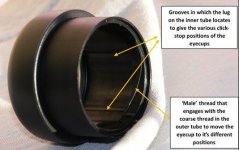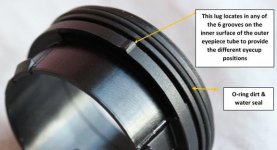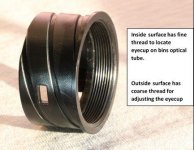A discussion concerning the workings of FL eyecups took place on the SF thread and I decided to disassemble one to investigate just how it worked. The results are posted here and on the next post.
FLs were fitted with at least 3 different eyecups over the years and I do not know exactly how they differed from each other. I have experience with 2 of them. The older one had a rather square or flat-topped rim that you pushed against your eye sockets and the later one which I have disassembled here, had a much rounder or semi-circular cross-section rim.
They consist of 3 tubular elements so there is an outer tube carrying the rubber part that buts up against your face and it also carries a coarse thread for screwing the eyecup up and down. Then there is an inner tube carrying the other part of the coarse thread and also the fine thread that secures the eyecup into the bins. Finally there is an in-between tube with an o-ring near the top to stop water and dust getting down into the eyecup workings and crucially it has a small moulded-in protuberance or ‘lug’ on its outer diameter. It is this lug that creates the click-stop effect every time it encounters one of 6 shallow longitudinal grooves on the inner surface of the outer eyecup tube as you rotate the eyecup to screw it out or in. The security of the click-stop (I mean how definite or positive it feels) depends on how well the lug clicks into each groove. This arrangement means that if you start with your eyecup 'clicked' into the full up or full down position and rotate it through 180 deg the lug should encounter two other grooves and therefore two other click-stop positions.
In the first pic below we have the three components lined up and from left to right they are:
The outer tube which is the one we are familiar with, then what I call the intermediate tube that is normally hidden even when we remove the eyecup from the bins for cleaning, and finally on the far right we have the inner tube.
The second pic is the outer tube in close-up with the important features indicated by the arrows and text boxes.
Lee
FLs were fitted with at least 3 different eyecups over the years and I do not know exactly how they differed from each other. I have experience with 2 of them. The older one had a rather square or flat-topped rim that you pushed against your eye sockets and the later one which I have disassembled here, had a much rounder or semi-circular cross-section rim.
They consist of 3 tubular elements so there is an outer tube carrying the rubber part that buts up against your face and it also carries a coarse thread for screwing the eyecup up and down. Then there is an inner tube carrying the other part of the coarse thread and also the fine thread that secures the eyecup into the bins. Finally there is an in-between tube with an o-ring near the top to stop water and dust getting down into the eyecup workings and crucially it has a small moulded-in protuberance or ‘lug’ on its outer diameter. It is this lug that creates the click-stop effect every time it encounters one of 6 shallow longitudinal grooves on the inner surface of the outer eyecup tube as you rotate the eyecup to screw it out or in. The security of the click-stop (I mean how definite or positive it feels) depends on how well the lug clicks into each groove. This arrangement means that if you start with your eyecup 'clicked' into the full up or full down position and rotate it through 180 deg the lug should encounter two other grooves and therefore two other click-stop positions.
In the first pic below we have the three components lined up and from left to right they are:
The outer tube which is the one we are familiar with, then what I call the intermediate tube that is normally hidden even when we remove the eyecup from the bins for cleaning, and finally on the far right we have the inner tube.
The second pic is the outer tube in close-up with the important features indicated by the arrows and text boxes.
Lee
Attachments
Last edited:








